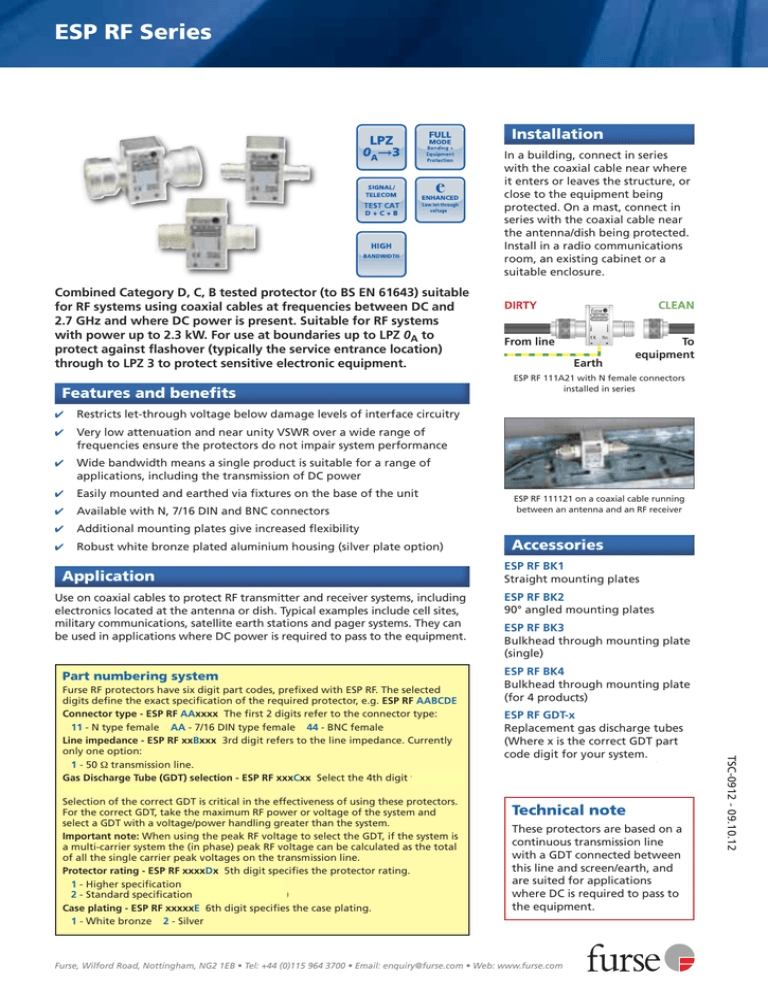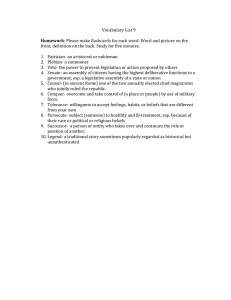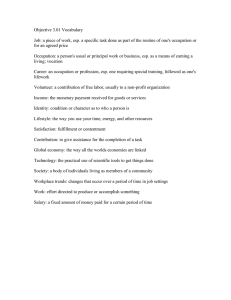ESP RF Series
advertisement

ESP RF Series Installation In a building, connect in series with the coaxial cable near where it enters or leaves the structure, or close to the equipment being protected. On a mast, connect in series with the coaxial cable near the antenna/dish being protected. Install in a radio communications room, an existing cabinet or a suitable enclosure. Combined Category D, C, B tested protector (to BS EN 61643) suitable for RF systems using coaxial cables at frequencies between DC and 2.7 GHz and where DC power is present. Suitable for RF systems with power up to 2.3 kW. For use at boundaries up to LPZ 0A to protect against flashover (typically the service entrance location) through to LPZ 3 to protect sensitive electronic equipment. Features and benefits ✔ Restricts let-through voltage below damage levels of interface circuitry ✔ Very low attenuation and near unity VSWR over a wide range of frequencies ensure the protectors do not impair system performance ✔ Wide bandwidth means a single product is suitable for a range of applications, including the transmission of DC power ✔ Easily mounted and earthed via fixtures on the base of the unit ✔ Available with N, 7/16 DIN and BNC connectors ✔ Additional mounting plates give increased flexibility ✔ Robust white bronze plated aluminium housing (silver plate option) Application Use on coaxial cables to protect RF transmitter and receiver systems, including electronics located at the antenna or dish. Typical examples include cell sites, military communications, satellite earth stations and pager systems. They can be used in applications where DC power is required to pass to the equipment. Part numbering system CLEAN From line Earth To equipment ESP RF 111A21 with N female connectors installed in series ESP RF 111121 on a coaxial cable running between an antenna and an RF receiver Accessories ESP RF BK1 Straight mounting plates ESP RF BK2 90° angled mounting plates ESP RF BK3 Bulkhead through mounting plate (single) ESP RF BK4 Bulkhead through mounting plate (for 4 products) ESP RF GDT-x Replacement gas discharge tubes (Where x is the correct GDT part code digit for your system. See GDT selection, page 259). Technical note These protectors are based on a continuous transmission line with a GDT connected between this line and screen/earth, and are suited for applications where DC is required to pass to the equipment. Furse, Wilford Road, Nottingham, NG2 1EB • Tel: +44 (0)115 964 3700 • Email: enquiry@furse.com • Web: www.furse.com TSC-0912 - 09.10.12 Furse RF protectors have six digit part codes, prefixed with ESP RF. The selected digits define the exact specification of the required protector, e.g. ESP RF AABCDE Connector type - ESP RF AAxxxx The first 2 digits refer to the connector type: 11 - N type female AA - 7/16 DIN type female 44 - BNC female Line impedance - ESP RF xxBxxx 3rd digit refers to the line impedance. Currently only one option: 1 - 50 Ω transmission line. Gas Discharge Tube (GDT) selection - ESP RF xxxCxx Select the 4th digit from the table at the bottom of page 259. Selection of the correct GDT is critical in the effectiveness of using these protectors. For the correct GDT, take the maximum RF power or voltage of the system and select a GDT with a voltage/power handling greater than the system. Important note: When using the peak RF voltage to select the GDT, if the system is a multi-carrier system the (in phase) peak RF voltage can be calculated as the total of all the single carrier peak voltages on the transmission line. Protector rating - ESP RF xxxxDx 5th digit specifies the protector rating. 1 - Higher specification (see pages 260-261) 2 - Standard specification (see pages 258-259) Case plating - ESP RF xxxxxE 6th digit specifies the case plating. 1 - White bronze 2 - Silver DIRTY ESP RF Series Technical specification IMPROVED Electrical specification ESP RF xx1x21 Gas Discharge Tube voltage Maximum working voltage Uc (RMS) 1 90 V 150 V 230 V 51 V 85 V 130 V 350 V 470 V 600 V 200 V 265 V 340 V 650 W 1.15 kW 1.90 kW 50 Ω Characteristic impedance Bandwidth DC-2.7 GHz ≤ 1.1 Voltage standing wave ratio ≤ 0.1 dB Insertion loss over bandwidth Maximum power1 40 W 120 W 280 W Transient specification ESP RF xx1x21 Let-through voltage (all conductors) Up 2 C2 test 4 kV 1.2/50 µs, 2 kA 8/20 µs to BS EN/EN/IEC 61643-21 < 700 V < 650 V < 700 V < 800 V < 900 V < 1050 V C1 test 1 kV, 1.2/50 µs, 0.5 kA 8/20 µs to BS EN/EN/IEC 61643-21 < 550 V < 450 V < 550 V < 650 V < 800 V < 950 V B2 test 4 kV 10/700 µs to BS EN/EN/IEC 61643-21 < 400 V < 350 V < 450 V < 550 V < 730 V < 800 V 5 kV, 10/700 µs3 < 430 V < 370 V < 470 V < 580 V < 750 V < 830 V Maximum surge current 4 D1 test 10/350 µs to BS EN/EN/IEC 61643-21 2.5 kA 8/20 µs to ITU-T K.45:2003, IEEE C62.41.2:2002 20 kA Mechanical specification ESP RF 111x21 ESP RF AA1x21 Temperature range ESP RF 441x21 -40 to +80 ºC Connection type 4 N female 7⁄16 DIN female Earth connection BNC female Via mounting fixtures Case material Aluminium, white bronze plated Weight - unit - packaged 120 g 140 g 190 g 210 g 90 g 110 g Dimensions The maximum RF working voltage and maximum power for the protectors is dependent on the GDT selected. See ‘Gas Discharge Tube selection’ below. 2 The maximum transient voltage let-through of the protector throughout the test (±10%). Response time < 10 ns. This let-through voltage represents a deviation from the applied signal voltage, present at the time of the test. 3 Test to IEC 61000-4-5:2006, ITU-T (formerly CCITT) K.20, K.21 and K.45,Telcordia GR-1089-CORE, Issue 2:2002, ANSI TIA/EIA/IS-968-A:2002 (formerly FCC Part 68). 4 The installation and connections external to the protector may limit the capability of the protector. 1 24 mm 24 mm 40 mm 40 mm 17.3 mm 17.3 mm 58 mm 56 mm 24 mm 24 mm 40 mm 25.8 mm 17.3 m 18 mm TSC-0912 - 09.10.12 78 mm Gas Discharge Tube selection Max RF voltage VPeak VRMS Max RF power 50 Ω system (PRMS) with VSWR = 2:1 GDT voltage code GDT part digit 72 V 51 V 40 W 90 V 1 120 V 85 V 120 W 150 V 2 185 V 130 V 280 W 230 V 3 280 V 200 V 650 W 350 V 4 375 V 265 V 1.15 kW 470 V 5 480 V 340 V 1.90 kW 600 V 6 Power levels have been de-rated to allow for real life ‘worst case’ conditions, calculated with VSWR as 2:1 M3 threaded channel, 5 mm deep 19.3 mm M3 threaded channel, 5 mm deep ESP RF BK1 Straight mounting bracket, 53 x 26.3 x 3 mm Two M4 clearance mounting holes, 16.3 mm apart ESP RF BK2 90° mounting bracket, 33 x 26.3 x 3 mm, 20 x 26.3 x 3 mm Two M4 clearance mounting holes, 16.3 mm apart, 14 mm from fold line ESP RF BK3 90° mounting bracket, 50 x 24 x 1.5 mm, 60 x 24 x 1.5 mm Two M5 clearance mounting holes, 40 mm apart ESP RF BK4 90° quad mounting bracket, 50 x 24 x 1.5 mm, 210 x 24 x 1.5 mm Five M5 clearance mounting holes, various spacings (Mounting brackets supplied with screws for fixing to protector) For RF applications where the connected equipment is very sensitive to transient overvoltages, use the higher specification RF protectors. ESP CCTV/B and ESP CCTV/T are suitable for use on coaxial (or twisted pair) CCTV lines. For coaxial CATV lines, use the CATV/F. Furse, Wilford Road, Nottingham, NG2 1EB • Tel: +44 (0)115 964 3700 • Email: enquiry@furse.com • Web: www.furse.com



